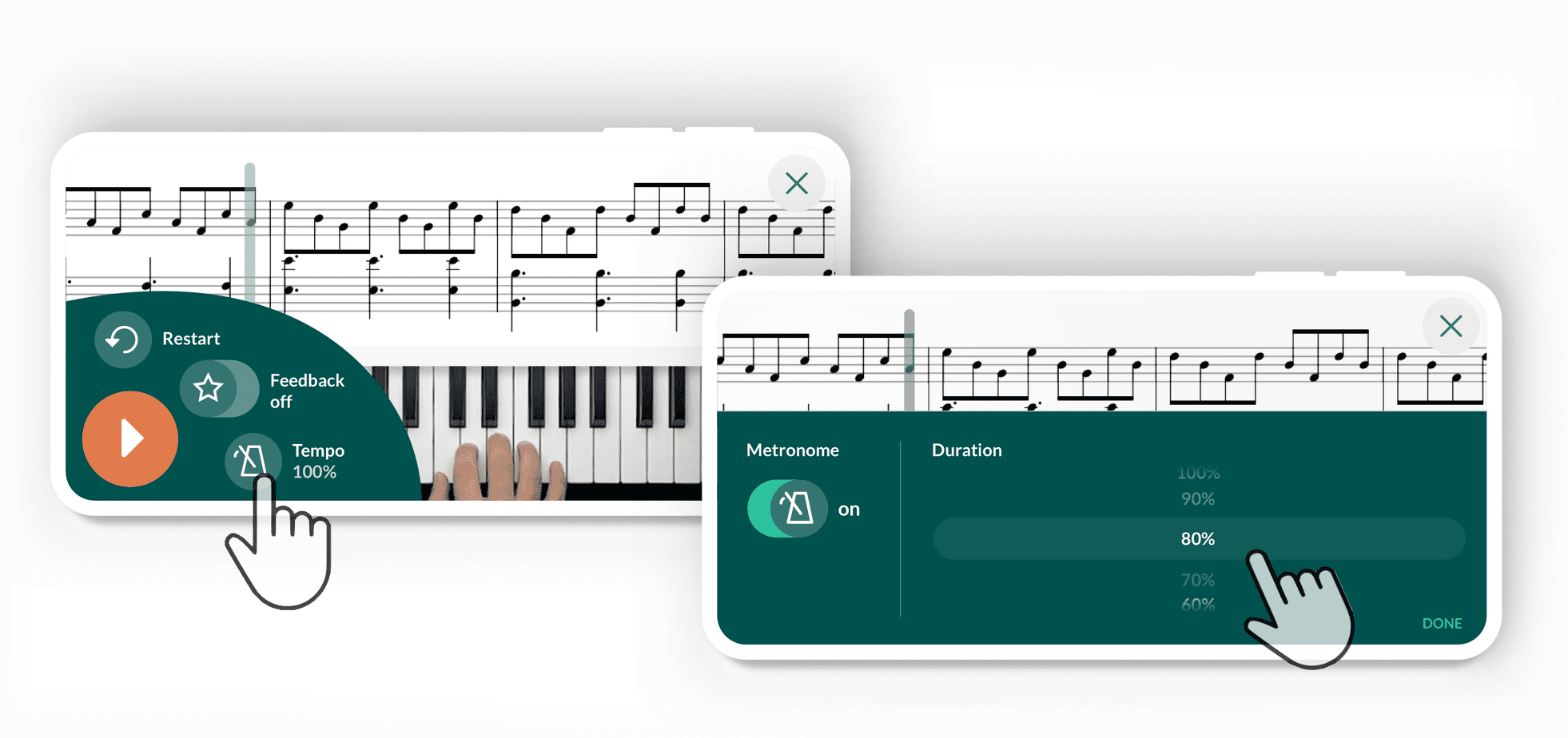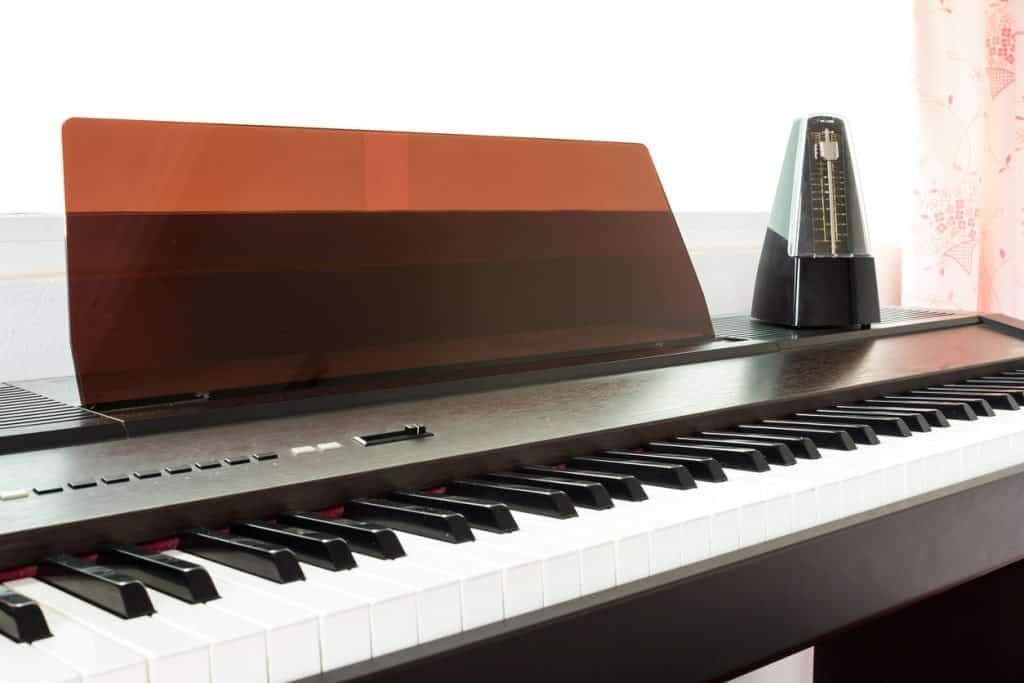The metronome is one of the most valuable practice tools available to you as a pianist. A piano metronome produces a steady pulse, which will help you to stay in time when playing and improve your rhythmic skills. The pulse can be sped up or slowed down by adjusting the tempo, which is usually measured in beats per minute or BPM.
Practicing regularly with a metronome can make learning new songs easier and more enjoyable. It can also help improve your skills when playing with other musicians. In this article, we will explore some of the uses of a metronome and learn a few different practice strategies to improve timing and rhythm with the metronome.

When to use a metronome
The metronome can be used in many different settings and for many different purposes. You can use a metronome when you are first learning a song to help solidify the rhythm. You can use it to improve your internal sense of timing, which is a crucial skill to develop as a pianist. You can use it while recording to ensure all tracks are performed in-sync with one another.
When first learning a song
When first learning a song, it can be really useful to practice it using a metronome. It is important to make sure you set the BPM at a slow tempo. This will help you to execute the rhythms in music accurately and help to imprint them into your memory. It is also important that you initially set the tempo slow enough so that you can play without getting stuck or losing time. Once you feel confident, you can start to speed up the metronome’s tempo. If a section of the song is still causing issues, simply turn the metronome back down to a slower tempo. This is a tried and true method to learn music quickly and efficiently.
To improve your inner sense of rhythm
Having a good sense of rhythm and inner timing is an important ability to have when performing, especially when you are playing with other musicians. Being able to play and maintain a consistent speed will ensure that your hands are moving in time together and that you are more in sync with your bandmates.
To get a taste for what it is like playing along with a band and to see how good your timing is, try and play along with the new Skoove metronome or a Skoove lesson. Try not to worry if you find it difficult to keep up at first. Just be patient and give it a few tries. Playing alongside a band like this or with the metronome is a great way to test and improve your timing.
Recording to a click track
When recording parts for a song, whether in a music studio or at home using music production software, you will usually have to record your parts to a click track metronome. It is important that you can do this with confidence and accuracy, so that your parts sound good and are in time with the rest of the track.
Try not be overwhelmed by the thought of playing to a click track though, just practice playing things with a metronome. Some musicians who do not practice regularly with the metronome find it difficult to record with a click track metronome when it comes time to record. If you practice with the metronome, you will be steps ahead and your recordings will most likely turn out better and rhythmically tighter!
Practice strategies for the metronome
There are myriad ways you can use the metronome to build your rhythmic skills. Think of using the metronome like drawing lines with a ruler; it is a tool that creates a perfectly even rhythmic pulse to practice with.
Metronome on all four beats
Probably the easiest and most common way to practice with the metronome is to have it play on all four beats. This is a consistent pulse that can easily be used in many situations such as learning melodies on the piano, practicing piano scales and arpeggios, or shifting around chord progressions. If you are new to the metronome, try practicing this strategy first.
Cut it in half
Once you feel comfortable with the metronome on all four beats, you can start to vary the number of beats that the metronome sounds on. This strategy will significantly boost your internal rhythmic skills over time because it forces you to count and feel the missing pulses internally.
The easiest way to do this is by cutting the BPM in half. For example, if you are practicing with the metronome on all four beats at 120 BPM, you can cut the BPM in half to 60 BPM. Then, you can imagine that the metronome is sounding on either beats 1 and 3 or on beats 2 and 4. At first, you might find it is easier to practice with the metronome on beats 1 and 3 as these are heavier beats that hold more gravity in most situations. However, you can also switch to beats 2 and 4 for an added challenge.
Metronome on one beat and beyond
Of course, you can continue stretching and extending the pulse of the metronome quite a bit. You can set the metronome to play on a single beat. For example, you can imagine that the metronome is only sounding on beat number 1. This means that you need to feel the following 3 beats internally and land again on beat 1. This is quite a challenging practice and a surefire way to build up your rhythmic skills.
The new metronome from Skoove
Skoove has added a metronome feature to their iOS, Android and Mac app for users to practice with. The Skoove metronome allows users to adjust the tempo in their practice all inside the Skoove app. Now you have the combination of hundreds of lessons on repertoire, theory and more with the added benefit of a metronome!

The beat goes on
Practicing with the metronome is one of the simplest and most effective strategies you can use to develop your rhythmic feel and sense of pulse. By practicing in a concentrated and focused way with the metronome, you are helping yourself to solidify the rhythms of difficult melodies and chord progressions, improving the ability of your hands to play in sync with one another, and preparing yourself to play with great rhythm and feel with other musicians.
There are so many ways to practice with the metronome. The only thing to remember is consistency is the key. With Skoove, you can practice and consistently expand your skills as a pianist. With the new metronome feature, you can make sure that your rhythmic skills are advancing. Try it out this week with some Skoove repertoire and keep the beat rolling on!
Author of this blog post:

Eddie Bond is a multi-instrumentalist performer, composer, and music instructor currently based in Seattle, Washington USA. He has performed extensively in the US, Canada, Argentina, and China, released over 40 albums, and has over a decade experience working with music students of all ages and ability levels.














